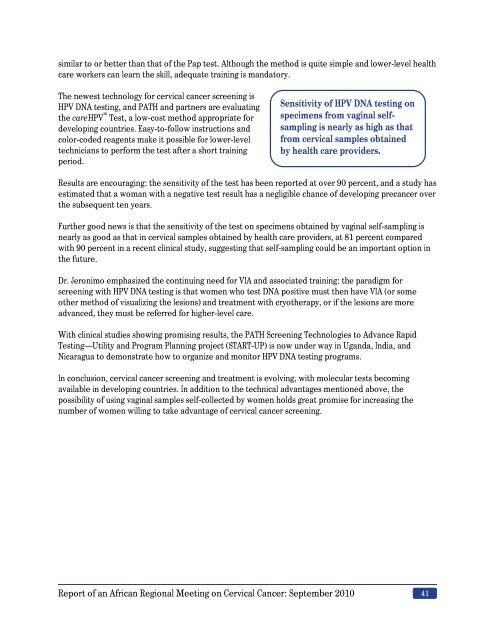Download file, English (1 MB PDF) - RHO
Download file, English (1 MB PDF) - RHO
Download file, English (1 MB PDF) - RHO
Create successful ePaper yourself
Turn your PDF publications into a flip-book with our unique Google optimized e-Paper software.
similar to or better than that of the Pap test. Although the method is quite simple and lower-level health<br />
care workers can learn the skill, adequate training is mandatory.<br />
The newest technology for cervical cancer screening is<br />
HPV DNA testing, and PATH and partners are evaluating<br />
the careHPV Test, a low-cost method appropriate for<br />
developing countries. Easy-to-follow instructions and<br />
color-coded reagents make it possible for lower-level<br />
technicians to perform the test after a short training<br />
period.<br />
Sensitivity of HPV DNA testing on<br />
specimens from vaginal selfsampling<br />
is nearly as high as that<br />
from cervical samples obtained<br />
by health care providers.<br />
Results are encouraging: the sensitivity of the test has been reported at over 90 percent, and a study has<br />
estimated that a woman with a negative test result has a negligible chance of developing precancer over<br />
the subsequent ten years.<br />
Further good news is that the sensitivity of the test on specimens obtained by vaginal self-sampling is<br />
nearly as good as that in cervical samples obtained by health care providers, at 81 percent compared<br />
with 90 percent in a recent clinical study, suggesting that self-sampling could be an important option in<br />
the future.<br />
Dr. Jeronimo emphasized the continuing need for VIA and associated training: the paradigm for<br />
screening with HPV DNA testing is that women who test DNA positive must then have VIA (or some<br />
other method of visualizing the lesions) and treatment with cryotherapy, or if the lesions are more<br />
advanced, they must be referred for higher-level care.<br />
With clinical studies showing promising results, the PATH Screening Technologies to Advance Rapid<br />
Testing—Utility and Program Planning project (START-UP) is now under way in Uganda, India, and<br />
Nicaragua to demonstrate how to organize and monitor HPV DNA testing programs.<br />
In conclusion, cervical cancer screening and treatment is evolving, with molecular tests becoming<br />
available in developing countries. In addition to the technical advantages mentioned above, the<br />
possibility of using vaginal samples self-collected by women holds great promise for increasing the<br />
number of women willing to take advantage of cervical cancer screening.<br />
Report of an African Regional Meeting on Cervical Cancer: September 2010 41
















